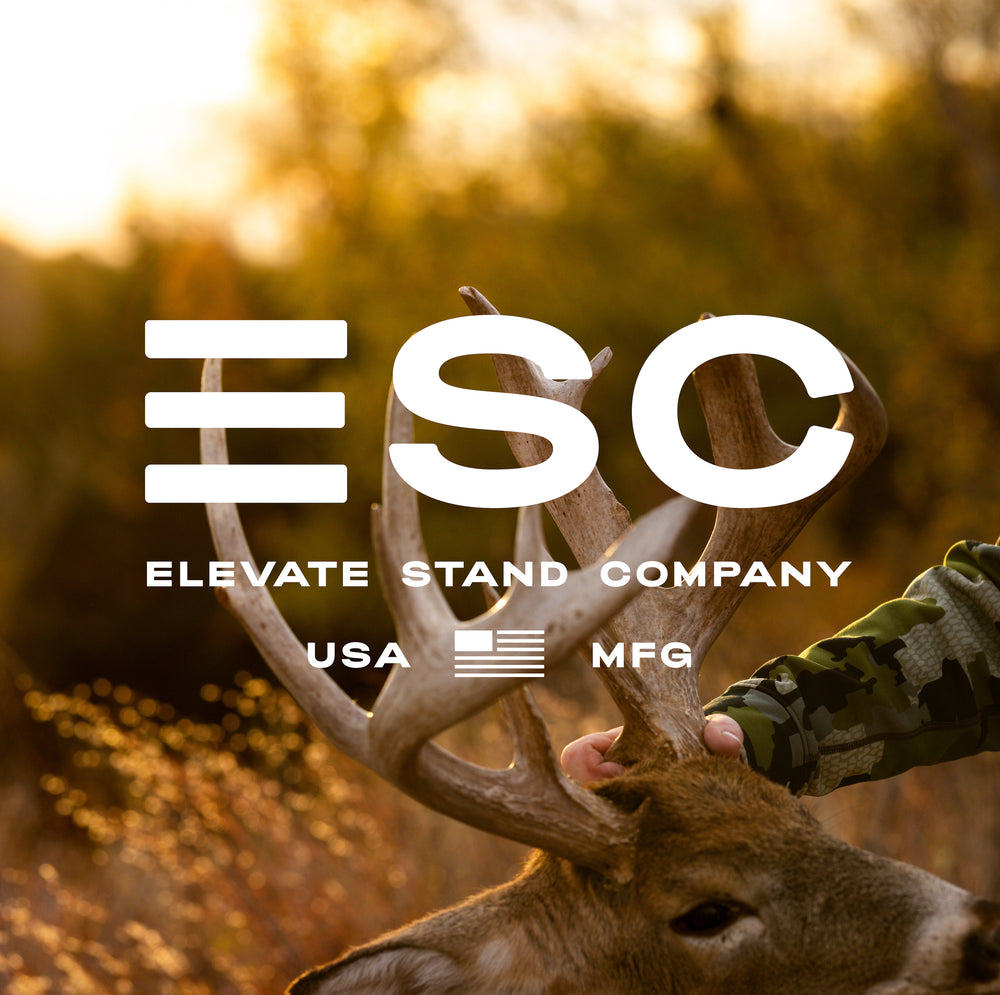Safety
Safety Instructions for: Element X, Rize X and the Ultra X Hang On Stands sold after 5/2025 and the Ascend Climbing Sticks.
* If you are looking for the safety instructions for the Element, Rize and Ultra Hang On Stands Manufactured before 3/2025 you can find them here.
Prior To Use You Must Read And Understand The Following Treestand/Climbing Stick Safety Guidelines
You Must Watch the Educational Videos at www.ElevateStand.Co
Do not exceed the climbing stick weight limit of 300 pounds.
Do not exceed the treestand’s weight limit. 350 pound limit (Element-X). 300 pound limit (Rize-X and Ultra-X).
This applies to the Ascend Climbing Sticks, Element-X, Rize-X, and Ultra-X treestands.
When using, installing, or removing a treestand, tripod or tower, falls can occur any time after leaving the ground causing injury or death.
When using, installing, or removing a treestand, always wear a (FAS) comprising a full body harness at all times after leaving the ground. You must stay connected at all times afer leaving the ground while using climbing sticks and while using, installing, or removing a treestand. If you are not wearing a full body harness properly attached to the tree that is protecting you from a fall, do not leave the ground.
Read and understand all of the manufacturer’s Warnings and Instructions and use all safety devices provided by the manufacturer. Contact the manufacturer for any questions. Failure to do so could result in injury or death.
Do not toe-hook an Elevate Treestand. It is not needed the way they are designed to bite into a tree. This can void your warranty.
Never exceed the total weight limit of a climbing stick or treestand.
Never use, install, or remove a climbing stick or treestand while taking drugs (even prescription drugs) or alcohol.
Never use, install, or remove a climbing stick or treestand during inclement weather such as rain, lightning, windstorms or icy conditions and end your hunt and return to the ground if inclement conditions arise.
Never use, install, or remove a climbing stick or treestand when feeling ill, nauseous or dizzy, or if you have a prior medical condition that could cause a problem i.e.,
heart condition, joints that lock-up, spinal fusions, etc. or if you are not well rested.
Never use, install, or remove a climbing stick or treestand on a dead, leaning, diseased or loose-barked tree or on a utility pole.
Never rely on a tree branch for support.
Never jump or bounce on a climbing stick or treestand to seat it to the tree.
Pull up a bow, backpack, firearm or other equipment only after being secure in the treestand. A firearm must be pulled up with it unloaded, chamber open and muzzle down.
Always inform someone of the hunting location, where you will be located and the expected duration of the hunt.
A signal device such a mobile phone, radio, whistles, signal flare or personal locator device (PLD) must be on your person and readily available at all times.
Never leave a climbing stick or treestand in a tree for more than two weeks since weather or animals could cause damage. Tree growth can also stress and damage straps and buckles that may not be visible or obvious to the ordinary eye.
Inspect the climbing stick or treestand and all safety devices each time before use and do not store your climbing stick(s) or treestand outdoors when not in use.
Never modify your climbing stick or treestand in any way by making repairs, replacing parts, or altering adding or attaching anything to it except if explicitly authorized in writing by the manufacturer.
Practice attaching, installing, adjusting, removing and using your climbing stick(s) or treestand at ground level prior to using it at elevated positions.
Instructions (written and video) should be kept in a safe place and reviewed at least annually. It is the responsibility of the climbing stick(s) or treestand owner to furnish the complete instructions to any person that borrows or purchases the climbing stick(s) or treestand.
The use of a lineman’s/climbing belt is required when installing and removing a climbing stick(s) or treestand to stabilize the user with the tree.
Correct tightening and adjustments of chains, cables, straps, etc. are critical to stable climbing stick(s) or treestand installation. All climbing stick(s) or treestand contact points must be in contact with the tree before you step onto your stick or stand.
Practice the attachment and removal of hang-on treestands at ground level before using in a hunting environment.
Use a haul line to raise and lower the climbing stick(s) or treestand. Never climb with anything on your back.
Climbing aids (stick ladders, sectional ladders, steps, etc.) must extend above the platform to allow the user to step down onto the platform of
your treestand.
Never step up to your stand from a climbing aid.
Fall Arrest System (FAS) and full body harness
Read and understand the manufacturer’s Warnings, expiration date and instructions on how to use and how to properly adjust the harness.
Practice the use of a full body harness at ground level in the presence of a responsible adult to experience the feeling of hanging suspended before using in a hunting environment.
The length of the harness tether must be minimized at all times. It should be adjusted so that it is above the head with no slack (snug) in the sitting position and you should have the minimum amount of slack possible when climbing.
Never allow the tether strap to get under your chin or around your neck.
Failure to follow harness instructions could result in not being able to return to the stand and being suspended in a harness after a fall. If the hunting location is unknown by anyone and communication efforts are unsuccessful, you must have a personal plan for recovery/escape because prolonged suspension in a harness can be fatal. It is important to exercise the legs by pushing against the tree or doing other forms of continuous leg exercises to avoid blood pooling while being suspended. Hunters with varying degrees of physical fitness may require different plans to recover/escape the effects of prolonged suspension. Have a personal plan and practice it in the presence of a responsible adult before leaving the ground. No one escape/rescue plan will work for every hunter on every tree in every circumstance. Only you can determine the best recovery/escape plan for your hunting situation and you must have a recovery/escape plan for your situation before leaving the ground.
A suspension relief device must be on your person and readily accessible while using a harness. These devices allow the user to relieve the load on the lower extremities if suspended in a harness and help maintain circulation in the legs, mitigate suspension trauma (blood pooling) or allow descent to the ground. Be sure to follow the manufacturer’s directions on the safe use of any suspension relief device.
Several optional products/systems are available that offer self-recovery or self-extraction from a fall when suspended in a harness. Some systems automatically descend the user while others allow user control. One of these products/systems could be considered for use as an additional safety precaution against prolonged suspension and suspension trauma. Be sure to follow the manufacturers’ directions on the safe use of these
products/systems.
Hunt from the ground when self- recovery/escape ability is absent.
There is time to make a correct decision on what action to take if a fall occurs while wearing a full body harness. It is important to remember, “DO NOT PANIC.” Remain calm and implement your practiced rescue, relief and recovery plan.
A full body harness with lineman’s/climbing belt must be worn at all times while installing or removing any hang-on climbing aids.
Climbing sticks must be placed on the tree at a height above the platform where the user can maintain a handhold on the unit and step downward onto the treestand. Never step up from a climbing device to get into your stand.
When using a lineman’s/climbing belt to ascend the tree, the full body harness should be attached to the tree before stepping down onto the treestand.
Sectional ladders and steps should be spaced on the tree to ensure each step is no more than 18 inches apart.
NEVER make modifications to a purchased climbing stick or treestand without the manufacturer’s written permission. Only purchase and use climbing sticks, treestands and Fall Arrest Harness Systems (FBFAHS) that meet or exceed industry standards recognized by TMA.
USE A FULL-BODY FALL ARREST HARNESS SYSTEM always wear and properly use a Full Body Fall Arrest Harness System (FBFAHS) that meets stringent, industry standards recognized by TMA. Wear a FBFAHS every time you leave the ground, including while ascending or descending. Single strap belts and chest harnesses are no longer allowed and shall not be used. Failure to use a FBFAHS could result in serious
injury or death.
USE YOUR HARNESS PROPERLY always attach your Full Body Fall Arrest Harness System (FBFAHS) in the manner and method described by the manufacturer. The FBFAHS tether should have no slack when sitting. Failure to do so may result in suspension without the ability to recover into your treestand. Be aware of the hazards associated with hanging suspended in a Full Body Fall Arrest Harness System (FBFAHS) and the fact that prolonged suspension in a harness may be fatal.
ALWAYS inspect the climbing stick, treestand and the Full Body Fall Arrest Harness System (FBFAHS) for signs of wear or damage before each use. Contact the manufacturer for replacement parts. Destroy all products that cannot be repaired by the manufacturer and parts that have exceeded the recommended expiration date. Destroy products if the manufacturer no longer exists. The FBFAHS must be discarded and replaced after a fall has occurred. It is suggested that you change out support cables after each season just to be safe since the steel cable is covered by rubber and it is hard to inspect. Nuts and bolts should be inspected for cracks or damage prior to each use.
SELECT A SAFE TREE. ALWAYS select the proper tree for use with your climbing stick and treestand. Select a live, healthy and straight tree that is within the size limits recommended by the manufacturer. Never select a leaning tree. Never leave your climbing stick(s) or treestand installed for more than two weeks since damage could result from changing weather conditions and/or from other factors not obvious with a visual inspection.
KNOW YOUR LIMITS ALWAYS and know your physical limitations. Don’t take chances. If you start thinking about how high you are, don’t go
any higher. The tree should be 4”-36” and must be able to hold your weight. Do not use a tree that cannot withstand the load of you and your gear.
ONLY USE CERTIFIED EQUIPMENT. NEVER use homemade or permanently elevated stands. NEVER make modifications to a purchased climbing stick or treestand without the manufacturer’s written permission. Only purchase and use climbing sticks, treestands and Fall Arrest Harness Systems (FBFAHS) that meet or exceed industry standards recognized by TMA.
USE A HAUL LINE always use a haul line to raise your backpack, gear, unloaded firearm or bow to your treestand once you have reached your desired hunting height. Never climb with anything in your hands or on your back. Prior to descending, lower your equipment on the side of the tree opposite of your descent route. When you remove the treestand from the tree lower it with your haul line.
Follow the instructions on elevatestand.co for installing on a tree.
Elevate Stand Co.
8003 Medora Rd
Hutchinson, KS 67502
WARNING: A Full Body/Fall Arrest Harness System does not come with your Elevate Stand Co treestand or climbing sticks. You must purchase and use a Full Body/Fall Arrest Harness System that meets TMA standards in order to use an Elevate Stand Co treestand and climbing sticks or any time that you leave the ground/come back to the ground. Failure to use the treestand, climbing stick or Full Body/Fall Arrest Harness System properly could result in injury or death of yourself or someone else.
04/2025




